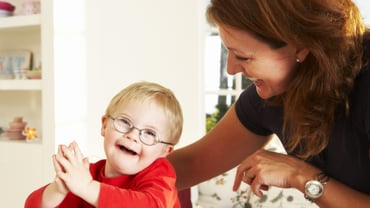Keys of Social Communication: Nonverbal
ALSO SEE: Social Communication – Engaging Your World
Body language involves posture and gestures, as well as eye contact. Body posture can tell us someone’s comfort or energy level, it can give us hints about their personal spaces, and it can also give clues to their interest in the environment or conversation. Gestures, particularly finger pointing, also gives clues. We can follow someone’s pointing finger to note something of interest, concern, or excitement. If someone is tapping their pen against the desk, shaking their knee, or tapping their foot, it may give us a clue that he/she is nervous, excited, or impatient. Someone may give us a ‘thumbs up’ to encourage, a ‘high five’ to celebrate, a ‘shrug’ to show uncertainty, or a balled up fist to show anger. There are so many more besides those, but they are just a few. Personal space is another aspect of body language that is important to remember, but isn’t a rule that is specifically taught. A friend ‘space’ versus a stranger ‘space’ is usually different. Eye contact is different based on cultures, but is generally viewed as a way to share information and interest. We will discuss more about eye contact when paired with facial expression below, but right now let’s look at eye contact as a communication skill. Eye contact cues turn-taking and interest in conversations, where a person’s attention might be focused, and shared emotional connection – which leads right into the topic of facial expression. Facial expression is a non verbal communication skills which usually is related to viewing people’s emotional states. Our faces communicate something different than our words sometimes too, or our faces communicate MORE than our words. Paired with the expression in the eyes (the windows to the soul), facial expression gives some of the best ‘readings’ into people’s emotions to such a point that some people can be human ‘lie detectors’ because they can read people’s faces so well. Emotions can move very quickly across the face, but a typical thinker’s brain is usually wired to catch those subtle changes and recognize them. This requires fast processing and then a fairly fast response to make the situation be successful. There are also times when people try to hide their emotions by making their facial expression not match their feelings. To add to the complexity, our own facial expressions are telling people information about us that we never speak. They are making decisions and assumptions about us based on our facial expressions. So what is your face communicating? Facial expression is a really tricky skill because it happens quickly, can be manipulated, and is sometimes a contradiction. For the typical thinker, though, it is a ‘built-in’ skill of the brain that is honed throughout the early years to process faster and more accurately. Like the other two, Tone of Voice, is also something that can tell you what a person is feeling when their words may say something else. Have you ever been on the phone with someone and their words say ‘they are fine’, but their tone of voice says ‘I’m really upset’. As a good listener and social communicator, we might try to find out what is really wrong. Tone of voice can also give us a hint of when to ‘back off’, particularly if the person sounds angry or when to prepare for some good news when a person’s voice sounds excited or when someone is joking or using sarcasm. For typical thinkers, tone of voice is like a little radar the ears pick up on to determine someone’s emotional state. Reading body language, giving body language, and responding appropriate to it in a timely manner is extremely fast, complex, and intricate. Even for those of us who are ‘typical thinkers’, these subtle nuances in social communication can be hard to recognize, let alone difficult to respond in the right way all of the time (playing with this miscommunication is where we get a lot of the sitcom humor, by the way). So just imagine how much difficulty atypical thinkers may have in solving the puzzle of nonverbal communication. Most people with slower processing speeds or with brains that are not ‘wired’ to read social communication, CAN be taught social communication skills. It may take patience and perseverance on both the teacher and the student’s part, but the skill of reading, understanding, and using nonverbal communication can be learned throughout the lifespan. To learn more about social communication, a great site is www.socialthinking.com.
Want to know how a Therapist can Help?
Call (828) 398 0043 or click on the schedule button.



